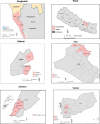Incidence of child marriage among refugees and internally displaced persons in the Middle East and South Asia: evidence from six cross-sectional surveys
- PMID: 37321808
- PMCID: PMC10277033
- DOI: 10.1136/bmjopen-2022-070056
Incidence of child marriage among refugees and internally displaced persons in the Middle East and South Asia: evidence from six cross-sectional surveys
Abstract
Objective: To examine incidence of child marriage among displaced and host populations in humanitarian settings.
Design: Cross-sectional surveys.
Setting: Data were collected in Djibouti, Yemen, Lebanon and Iraq in the Middle East and in Bangladesh and Nepal in South Asia.
Participants: Adolescent girls aged 10-19 in the six settings and age cohort comparators.
Outcome measures: Cumulative incidence of marriage by age 18.
Results: In Bangladesh and Iraq, the hazard of child marriage did not differ between internally displaced populations (IDPs) and hosts (p value=0.25 and 0.081, respectively). In Yemen, IDPs had a higher hazard of child marriage compared with hosts (p value<0.001). In Djibouti, refugees had a lower hazard of child marriage compared with hosts (p value<0.001). In pooled data, the average hazard of child marriage was significantly higher among displaced compared with host populations (adjusted HR (aHR) 1.3; 95% CI 1.04 to 1.61).In age cohort comparisons, there was no significant difference between child marriage hazard across age cohorts in Bangladesh (p value=0.446), while in Lebanon and Nepal, younger cohorts were less likely to transition to child marriage compared with older comparators (p value<0.001). Only in Yemen were younger cohorts more likely to transition to child marriage, indicating an increase in child marriage rates after conflict (p value=0.034). Pooled data showed a downward trend, where younger age cohorts had, on average, a lower hazard of child marriage compared with older cohorts (aHR 0.36; 95% CI 0.29 to 0.4).
Conclusions: We did not find conclusive evidence that humanitarian crises are associated with universal increases in child marriage rates. Our findings indicate that decision-making about investments in child marriage prevention and response must be attuned to the local context and grounded in data on past and current trends in child marriage among communities impacted by crisis.
Keywords: Child protection; EPIDEMIOLOGY; REPRODUCTIVE MEDICINE.
© Author(s) (or their employer(s)) 2023. Re-use permitted under CC BY-NC. No commercial re-use. See rights and permissions. Published by BMJ.
Conflict of interest statement
Competing interests: None declared.
Figures





References
-
- OHCHR . Convention on the elimination of all forms of discrimination against women. Available: https://www.ohchr.org/en/professionalinterest/pages/cedaw.aspx [Accessed 6 Oct 2019].
-
- UNICEF . Child marriage: latest trends and future prospects. UNICEF DATA; 2018. Available: https://data.unicef.org/resources/child-marriage-latest-trends-and-futur... [Accessed 1 Jan 2021].
-
- Malhotra A, Elnakib S. Evolution in the evidence base on child marriage 2000-2019. UNFPA-UNICEF Global Programme to End Child Marriage 2020.
Publication types
MeSH terms
Grants and funding
LinkOut - more resources
Full Text Sources
Miscellaneous
